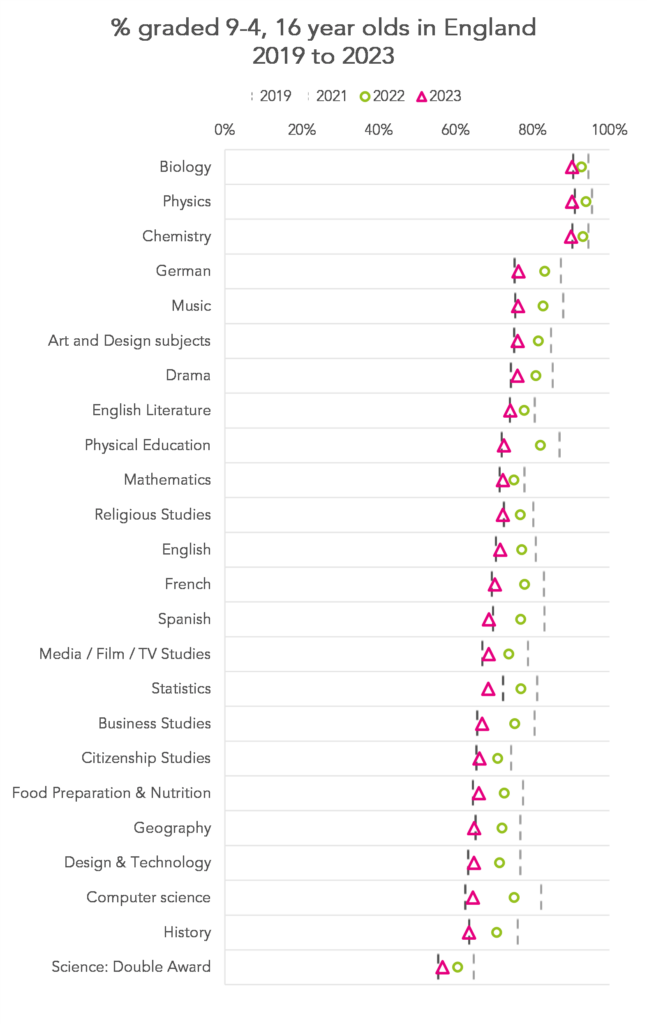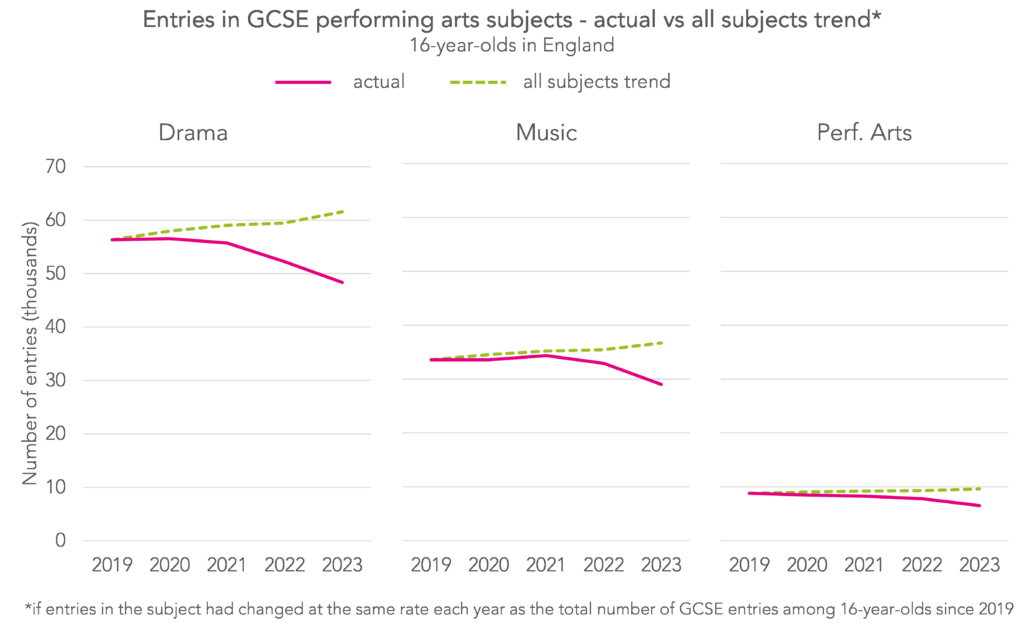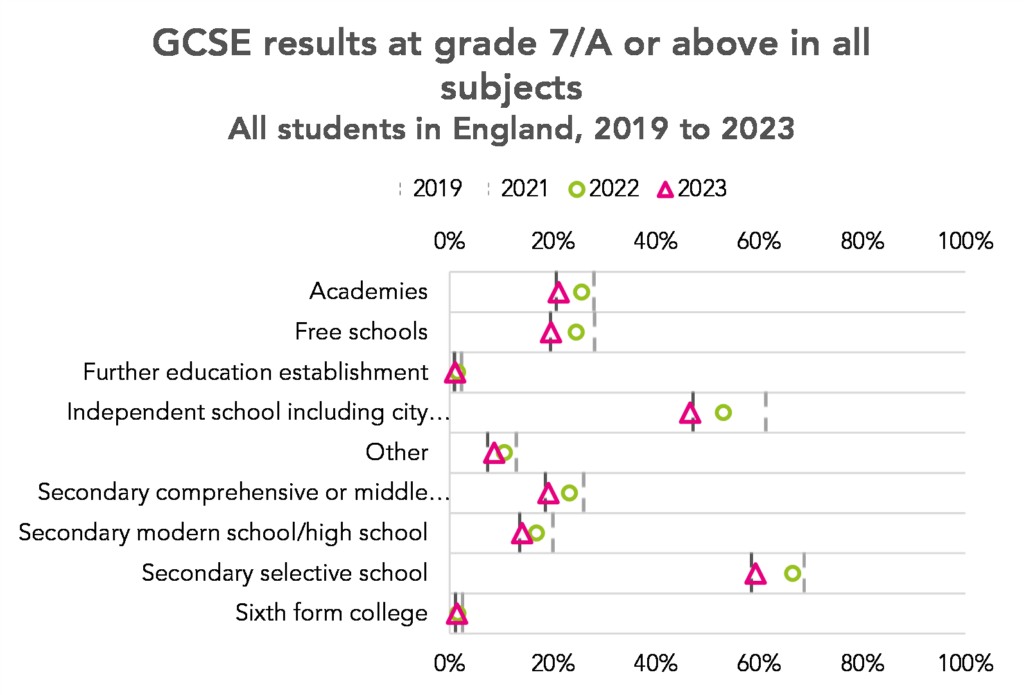GCSE results are out today. And, as always, we’ve analysed the data that’s been published to bring you a round up of everything that you need to know.
Grades in England have fallen, but not quite back to 2019 standards
The fall in the grades is no surprise – back in autumn last year, Ofqual confirmed that grades this year would return to pre-pandemic levels.
And, as expected, grades this year are much closer to 2019 levels than last year. But they remain slightly above those in 2019.

Early Results Service
FFT’s Secondary Early Results service is the fastest way to get a national analysis of all your 2023 results before the Autumn term.
Free to all Aspire schools, this year’s service has been extended to include A-levels as well as KS4.
Aspire schools can upload results now.
Not an FFT Aspire user? Learn more here.
This year, 22.7% of GCSEs were graded 9-7, compared to 21.9% in 2019. And 70.5% were graded 9-4, compared to 69.9% in 2019.
On the other hand, the proportion graded 9-1 is slightly down: this year, it stands at 98.1%, compared to 98.4% in 2019.
For anyone who’s not clear on why grades were higher during the pandemic, here’s a quick primer. In both 2020 and 2021, public exams were cancelled and grades were awarded using different systems, known as Centre Assessment Grades (CAGs) and Teacher Assessed Grades (TAGs).
The grades awarded using CAGs and TAGs were higher, on average, than those awarded in more typical years. And last year, to avoid a sudden sharp fall in grades, they were adjusted to a level between their peak in 2021 and the level in 2019, the year before the pandemic affected exams.
Subject differences
Ofqual signalled that grades awarded in 2023 would return to 2019 standards and that is exactly what we see in this year’s results. Results have fallen in all subjects compared to last year and are now in line with 2019 results.
At grades 9-7, 2023 results are mostly within 2 percentage points of 2019 results for the subjects shown (the 24 with the most entries by 16 year olds in England). Results in statistics were slightly lower (18.2% in 2023 compared to 20.5%) but this may be explained by a change in the entry profile of students. There were 28% more entries in 2023 than in 2019.
By contrast, there has been a 12% increase in entries in computer science since 2022. This is on top of increases in entries at A-level as well. However, prior to that entries had remained rather flat despite the increase in population size. 24% of entries were awarded grades 9-7 in 2023 compared to 21% in 2019.
9-7 grades in French and German (but not Spanish) also remained above 2019 levels. This is welcome given the relative difficulty of MFL compared to other subjects. This follows work by Ofqual to adjust the grading standards in French and German in 2020. However, we wrote at the time that these adjustments were unlikely to go far enough but will examine this year’s results later in the year.
Now, let’s turn to grades 9-4.

As at grades 9-7, most differences between figures for 2023 and 2019 are within 2 percentage points. The exception was again statistics with a fall of 4 percentage points.
Attainment improved slightly (by less than 1 percentage point) in French and German but fell by a similar amount in Spanish.
72% of pupils achieved grades 9-4 in maths. Consequently, around 28% of the cohort will have to study maths in the Autumn as part of their post-16 programme of study. The calculation for English is slightly more complicated as some of the pupils who did not achieve grade 4 in English language may have achieved grade 9-4 in English literature and therefore not have to study English post-16.
Finally a word on fails (grade U) in English. 1.6% of entries were graded U in 2023 compared to 1.0% in 2019. This is a finding worth digging into later in the year alongside data relating to pupils who were not entered at all.
Entries to performing arts subjects continue to decline, business studies sees big increases
The subjects with the biggest proportional drops in entries since last year are the performing arts subjects: drama, music and performing/expressive arts. As the chart below shows, this is part of a longer-term trend, although it should be remembered that there are a number of popular vocational and technical qualification in these subjects which aren’t included here.
The subjects with the biggest increases in entries since last year are statistics, business studies and social science subjects.
Entries in business studies and social science subjects had been increasing in recent years. Statistics had seen a drop in entries over the pandemic years, perhaps reflecting its traditional status as an “extra” subject, with the increase this year representing a recovery.
Attainment at grades 9-7 in independent schools is below that in 2019
The percentage of GCSE entries graded 9-7 in independent schools in 2023 (46.6%) was lower than in 2019 (47.2%). By contrast, attainment in state-schools remained above 2019 levels.
At this stage, we don’t know whether this might be at least partially explained by changes in entries in international GCSEs, which won’t be included in these figures.
We wrote last year about how we thought the percentage of 9-7 grades awarded by independent schools was too high when awarded by centre assessment grades in 2020 and teacher assessed grades in 2021.
A note of caution with the above chart is that the centre types are self-declared by centres rather than those typically used to report school performance statistics such as those found in Get Information About Schools. For example, the underlying data shows that there were 86 secondary selective schools- just over half the true number.
The figures presented by Ofqual are also based on all pupils in England rather than just 16 year olds, which would be a better comparison.
Proportions of top grades awarded is higher than pre-pandemic in Wales and Northern Ireland
Grades in England have largely returned to pre-pandemic levels. However, in Wales and Northern Ireland, they remain higher.
The proportion of 16-year-old pupils achieving the top grades is 0.5 percentage points higher in England this year compared with 2019, but in Wales it’s 2.2 percentage points higher, and in Northern Ireland it’s 3.7 percentage points higher. This is similar to the picture we saw at A-level.
Qualifications in Wales and Northern Ireland are not regulated by Ofqual, so their path back to pre-pandemic standards was always going to be different. There are also differences (pdf) in the way qualifications are structured and assessed in the three countries which makes comparison between the three countries difficult.
Regional differences in grades are not going away
This year, 28.4% of GCSEs entered in London were graded 9-7. This compares to just 17.6% in the North East.

Last year there was a similar story: 32.6% of London GCSEs were graded 9-7, compared to 22.5% in the North East.
And likewise if we look back to pre-pandemic: in 2019, 25.7% of London GCSEs were graded 9-7, compared to 16.4% in the North East.
So it’s fair to say that GCSEs entered in the capital are more likely to receive top grades than those in the rest of the country, and this has been the case for at least the last five years. The North East has tended to be the region in which GCSEs are least likely to receive a top grade, along with Yorkshire and Humber.
And the gap has widened slightly since 2019, when the difference between London and the North East stood at 9.3 percentage points. This year, it was 10.8 percentage points.
The higher rate of attendance in London may be a factor.
One thing to bear in mind is that these figures are taken from JCQ, who include students of all ages and all types of schools in their statistics. It will be later in the term before we see figures for end of Year 11 pupils in state-funded schools, which may give a better sense of whether inequality has widened since the start of the pandemic.
The National Reference Test showed a fall in maths relative to 2019
The National Reference Test (NRT) is a fairly new idea, with the first tests taking place in 2017. Its aim is to give a sense of if (and by how much) standards in English and maths are changing over time.
Briefly, a sample of Year 11 pupils take a set of English and maths tests in the spring before their GCSEs. The idea was (in pre-pandemic times) that if the results showed that performance was higher or lower than usual, Ofqual could ask exam boards to adjust grade boundaries.
Results in both English and maths, both at the 9-4 boundary and the 9-7 boundary, have exhibited some variability over time although remember that these figures are based on around 6,500 students with a considerable degree of non-response (see the report for more detail).
But performance in English at the 9-7 boundary was slightly higher than in 2019 but in line with performance at the 9-4 boundary although it should be noted that performance in 2019 was lower than in either year either side. It was also slightly higher than in 2022, the caveat about the size of the sample notwithstanding.
By contrast, performance in maths was lower than in 2019 at both the 9-7 and 9-4 boundary. It was also lower than 2022.
Perhaps these results are unsurprising given the continuing level of disruption faced by this cohort of pupils. That said, on the surface at least, it could be argued that the differences compared to pre-pandemic times are relatively modest given the amount of upheaval schools and pupils have had to deal with.
Even though the results show a small drop in performance in maths, Ofqual decided to keep grading standards in line with those in 2019 and not lower them further.
The gender gap in top grades has narrowed
This year, 25.7% of GCSEs entered by female pupils achieved a grade 7 or above, compared to 19.7% of those entered by male pupils.

Gender gaps in GCSE grades are a long-term trend, but the gap in those achieving top grades widened during the pandemic.
At its peak in 2021, it stood at 9.2 percentage points. This year’s gap of 6.0 percentage points is actually lower than the pre-pandemic gap of 6.7 percentage points in 2019.
On the other hand, the gender gap in those achieving grade 9-4 narrowed slightly during the pandemic. In 2019, it stood at 8.9 percentage points, but fell to 6.9 percentage points in 2021.
This year, the gap at grades 9-4 is at its lowest level since 2019, just 6.8 percentage points, with 73.9% of GCSEs entered by female pupils and 67.1% those entered by male pupils achieving 9-4.
Resits in English and maths are up, but grades are down
Pupils who do not achieve at least a grade 4 in GCSE English and maths are currently required to carry on studying them post-16. Those who achieve grade 3 are required to continue to study GCSE. For other pupils, they can study either GCSE or functional skills.
And the number of resits has increased considerably this year following last year’s drop in grades.
The chart below shows the number of entries to GCSE maths and English by those aged 17 or above. These entries will mainly be resits.

Entries fell during the pandemic when more pupils reached the grade 4 threshold in 2020 and 2021. They are still well below 2019 levels but will likely return to a similar point next year.
Grades in English and maths GCSEs entered by those aged 17 and above remain considerably below 2019 levels, as they were last year.

This year, 25.9% achieved a grade 9-4 in English, compared to 30.3% in 2019. And in maths, the figures are 16.4% this year compared to 21.2% in 2019.
For 16 year olds in the same subjects, grades this year are similar to 2019.
This difference is probably because fewer pupils took resits this year than in 2019. If 2019 standards had applied last year when pupils took exams in Year 11 then a larger number would not have achieved 9-4 and therefore had to resit this year. But to be sure we would also need to run the analysis combining entries in Autumn and Summer.
Want to stay up-to-date with the latest research from FFT Education Datalab? Sign up to Datalab’s mailing list to get notifications about new blogposts, or to receive the team’s half-termly newsletter.












When looking at regional differences, does the data include all school types? Are there different proportions of independent and state-selective schools around the country? A comparison of (non-selective?) state funded schools only might be helpful for informing the discourse around widening north/south divide and whether education recovery policies are “too London-centric” (Chris Zarraga, director of Schools North East).
Yes, unfortunately all types are included and there is a disproportionately high number of pupils in independent schools in London. Unfortunately the data published by JCQ is all that is available at the moment. But I agree that a comparison of state-funded schools would be better for thinking about the question you ask. It will only be later in the term when DfE has produced data for the Performance Tables checking exercise that we will get a sense of this.
JCQ stated that 34.5% received grade A/7 and above. This is very different from your stats. Is there a reason why which I haven’t seen?
All the figures we quote (bar those relating to centre types) come from JCQ stats. They report a number of different age/ country breakdowns so chances are you’re looking at figures reporting on a different base population to the ones we’ve used here
In your paragraph stating that English is complicated…if a student does not get English Language at a grade 4 or above, they must resit. Your paragraph suggests that if the get a 4 for Literature they do not have to resit.
Hi Julia. We’re quoting from the 16-18 funding guidance which states that you do not need to resit English if you achieve 9-4 in literature https://www.gov.uk/guidance/16-to-19-funding-maths-and-english-condition-of-funding
Is it possible to get the precise percentage numbers used in the second chart, i.e. % graded 7-9 per subject please? For A Levels you have a drop down menu that allows one to do this. Thanks.
Hi Ferdinand. This is pulled together based on JCQ data – I think you’d need to go into the ‘other results information’ section to find the relevant bit. But to save you digging around on there, here’s the extracted data that we used for the chart. It shows the % of 16 yrs olds in England achieving grade 7-9 by subject.